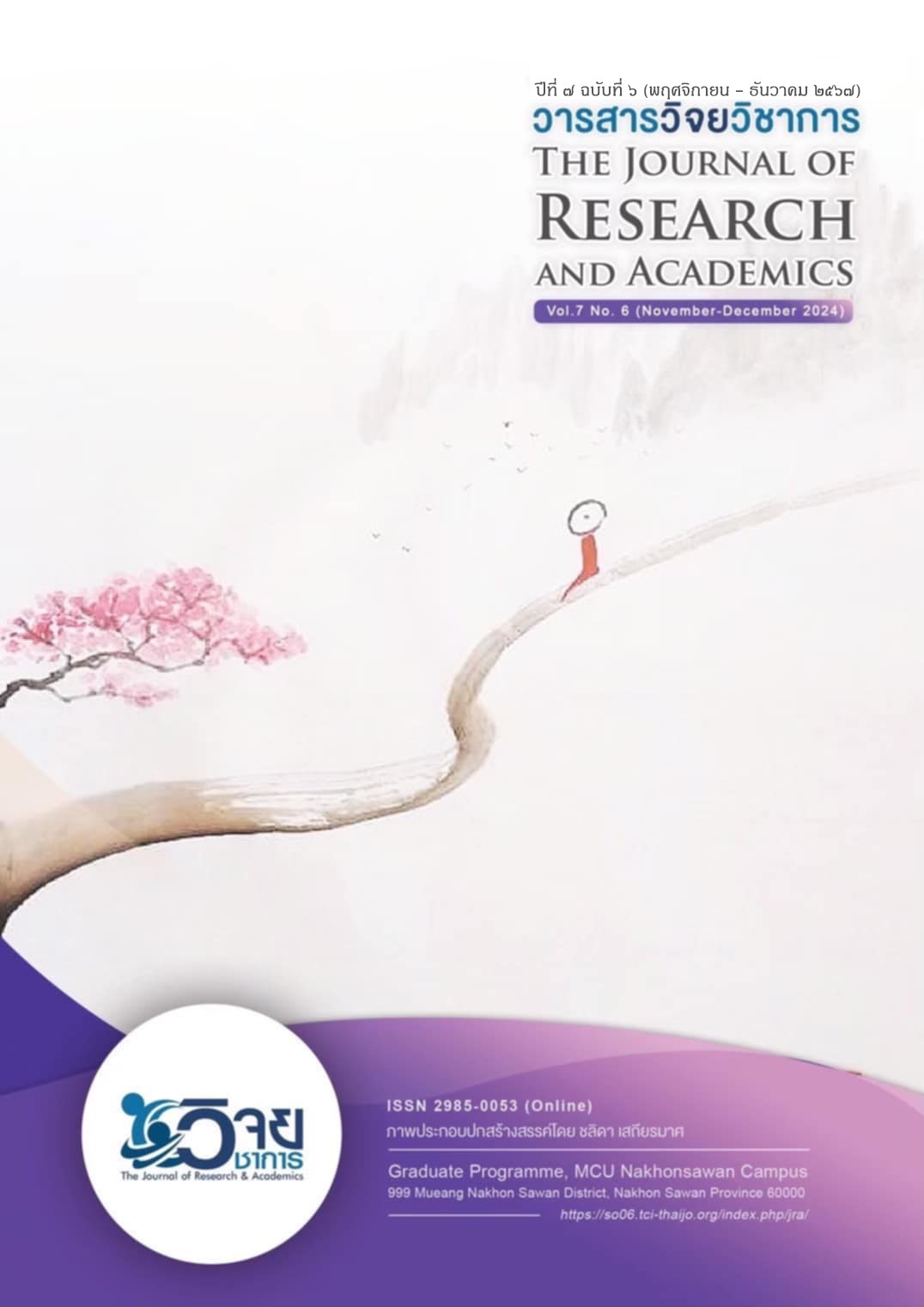การสำรวจองค์ประกอบของการรับรู้ความหลากหลายและการยอมรับความแตกต่างของพนักงาน : การศึกษาเชิงประจักษ์ในภาคการผลิต
Main Article Content
บทคัดย่อ
บทความวิจัยนี้มีวัตถุประสงค์เพื่อวิเคราะห์องค์ประกอบเชิงสำรวจของการรับรู้ความหลากหลายและการยอมรับความแตกต่างของพนักงาน โดยศึกษาจากพนักงานโรงงานแห่งหนึ่งในจังหวัดชลบุรี จำนวนพนักงานทั้งหมด 3,314 คน ใช้วิธีการสุ่มแบบแบ่งชั้นตามสัดส่วนจำนวน 260 คน เครื่องมือที่ใช้วัดในการวิจัย คือ แบบสอบถามลักษณะมาตราส่วนประมาณค่า 5 ระดับ ที่ผู้วิจัยพัฒนาขึ้นจำนวน 19 ข้อ ข้อคำถามสามารถวัดถึงการรับรู้ความหลากหลายและการยอมรับความแตกต่างของพนักงานได้จริงและเชื่อถือได้ โดยพิจารณาจากค่า IOC อยู่ระหว่าง 0.67 และ 1.00 ค่าสัมประสิทธิ์ความเชื่อมั่น 0.943 ข้อมูลที่ใช้ในการศึกษามีความสัมพันธ์กันสามารถนำมารวมกลุ่มกันเป็นองค์ประกอบหรือสามารถทำการสกัดเป็นองค์ประกอบได้ โดยพิจารณาจากค่า KMO = 0.965, Bartlett's Test of Sphericity มี Chi-Square = 4,059.082, df = 171, p < 0.001 และค่าการร่วมระหว่าง 0.662 ถึง 0.769 ผลการสกัดองค์ประกอบด้วยการวิเคราะห์องค์ประกอบหลัก และหมุนแกนแบบตั้งฉากด้วยวิธีวาริแมกซ์ สกัดได้เป็น 3 องค์ประกอบ โดยมีค่าไอแกนเท่ากับ 11.121, 1.314 และ 1.07 ตามลำดับ อธิบายค่าความแปรปรวนได้ร้อยละ 58.534, 6.916 และ 5.634 ตามลำดับ ค่าความแปรปรวนสะสมร้อยละ 71.084 ผลการวิจัย พบว่า องค์ประกอบที่ 1 การยอมรับความแตกต่างและเป็นส่วนหนึ่งในกลุ่ม ประกอบด้วย 10 ตัวบ่งชี้ มีค่าน้ำหนักองค์ประกอบระหว่าง 0.577 ถึง 0.817 องค์ประกอบที่ 2 ความผูกพันในการทำงานร่วมกันในกลุ่มงาน ประกอบด้วย 5 ตัวบ่งชี้มีค่าน้ำหนักองค์ประกอบระหว่าง 0.729 ถึง 0.811 และองค์ประกอบที่ 3 ความสามารถในการเข้าถึงการสื่อสารและทรัพยากร ประกอบด้วย 4 ตัวบ่งชี้ ค่าน้ำหนักองค์ประกอบระหว่าง 0.638 ถึง 0.76
Article Details

อนุญาตภายใต้เงื่อนไข Creative Commons Attribution-NonCommercial-NoDerivatives 4.0 International License.
1. เนื้อหาและข้อมูลในบทความที่ลงพิมพ์กับวารสารวิจยวิชาการ ถือเป็นข้อคิดเห็น และความรับผิดชอบของผู้เขียนบทความโดยตรงซึ่งกองบรรณาธิการวารสารไม่จำเป็นต้องเห็นด้วย หรือร่วมรับผิดชอบใด ๆ
2. บทความ ข้อมูล เนื้อหา รูปภาพ ฯลฯ ที่ได้รับการตีพิมพ์ในวารสารวิจยวิชาการ ถือเป็นลิขสิทธิ์ของวารสารวิจยวิชาการ หากบุคคลหรือหน่วยงานใดต้องการนำทั้งหมดหรือส่วนหนึ่ง ส่วนใดไปเผยแพร่ต่อหรือเพื่อการกระทำการใด ๆ จะต้องได้รับอนุญาตเป็นลายลักษณ์อักษรจากวารสารวิจยวิชาการก่อนเท่านั้น
เอกสารอ้างอิง
กัลยา วานิชย์บัญชา. (2552). การวิเคราะห์สถิติ สถิติเพื่อการตัดสินใจ. (พิมพ์ครั้งที่ 4). กรุงเทพฯ : บริษัทธรรมสารจํากัด.
ธานินทร์ ศิลป์จารุ. (2563). การวิจัยและวิเคราะห์ข้อมูลทางสถิติด้วย SPSS และ AMOS. (พิมพ์ครั้งที่ 18). กรุงเทพฯ : บิสซิเนสอาร์แอนด์ดี.
วารุณี จันทาพูน. (2562). อิทธิพลของการรับรู้ความเป็นส่วนหนึ่งขององค์การ ต่อผลการปฏิบัติงานโดยมีความผูกพันในองค์การ และความพึงพอใจในการปฏิบัติงานเป็นตัวแปรส่งผ่านของพนักงานรัฐวิสาหกิจแห่งหนึ่ง. (วิทยานิพนธ์ศิลปศาสตรมหาบัณฑิต สาขาวิชาจิตวิทยาประยุกต์). บัณฑิตวิทยาลัย : มหาวิทยาลัยศรีนครินทรวิโรฒ.
Avery, D. R., McKay, P. F., Wilson, D. C., & Volpone, S. (2008). Attenuating the effect of seniority on intent to remain: The role of perceived inclusiveness. Journal of Management, 37(4), 1-58. https://doi.org/10.1177/0149206310385943
Cho, S. & Mor Barak, M. E. (2008). Understanding of diversity and inclusion in a perceived homogeneous culture: A study of organizational commitment and job performance among Korean employees. Administration in Social Work, 32(4), 100-126. https://doi.org/10.1080/03643100802293865
Donders, Y. (2010), Do cultural diversity and human rights make a good match?, International Social Science Journal, 61(199), 15-35.
Hair, J. F., Black, W. C., Babin, B. J., & Anderson, R. E. (2010). Multivariate Data Analysis. (7th ed.). New York : Pearson Education.
Hoe, S. L. (2008). Issues and procedures in adopting Structural Equation Modeling technique. Journal of Applied Quantitative Methods, 3(1), 76-83.
Hwang, J. & Hopkins, K. M. (2015). A structural equation model of the effects of diversity characteristics and inclusion on organizational outcomes in the child welfare workforce. Children and Youth Services Review, 50, 44–52.
Jaiswal, A. & Dyaram, L. (2020). Perceived diversity and employee well-being: mediating role of inclusion. Personnel Review, 49(5), 1121-1139.
Jaiswal, A. & Khatric, N. (2022). Interplay of diversity, inclusion, and politics: Impact on employee well-being. IIMB Management Review, 34(10), 195-207.
Lennox, R., Herlihy, P., Sharar, D. & Robey, M. (2022). Construction and validation of a short inclusion scale. World at Work. The Journal of Total Rewards, 4(11), 22-43.
Mor Barak, M. E. & Brimhall, K. C. (2018). The critical role of workplace inclusion in fostering innovation, job satisfaction, and quality of care in a diverse human service organization. Human Service Organizations Management, 42(5), 474-492.
Mor Barak, M. E., Brimhall, K. C. & Lizano, E. L. (2014). The mediating role of inclusion: A longitudinal study of the effects of leader–member exchange and diversity climate on job satisfaction and intention to leave among child welfare workers. Children and Youth Services Review, 40, 79-88.
Mor Barak, M. E., Findler, L. & Wind, L. H. (2001). Diversity, inclusion, and commitment in organizations: international empirical explorations. Journal of Behavioral and Applied Management, 2(2), 70-91.
Ranieri, D. (2020). The impact of employee perception of inclusion and psychosocial capital on meaningful engagement in organizations. (Dissertation Doctor of Business Administration). California school of Management and Leadership Alliant International University.
Roberson, Q. M. (2006). Disentangling the meanings of diversity and inclusion in organizations. Group & Organization Management, 31(2), 212-236.
Webber, S. S. & Donahue, L.M. (2001), Impact of highly and less job-related diversity on work groupcohesion and performance: a meta-analysis, Journal of Management, 27(2), 141-162.


